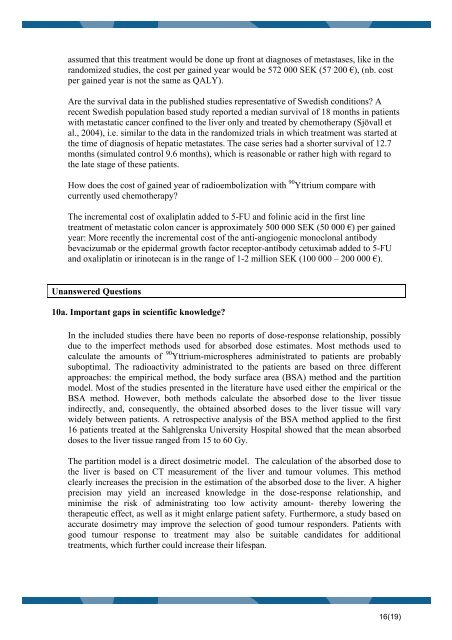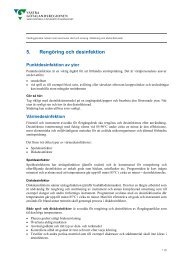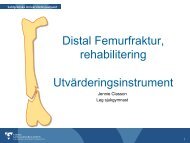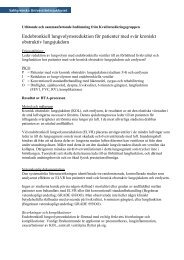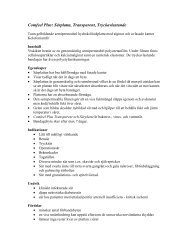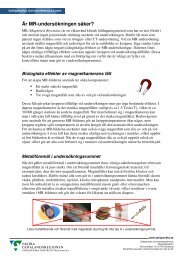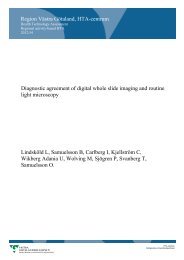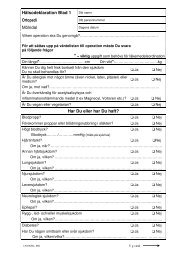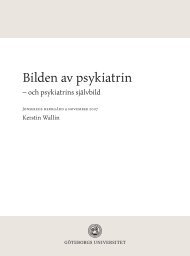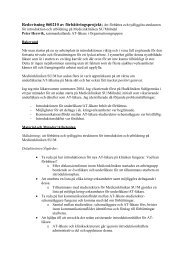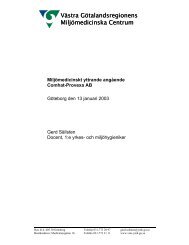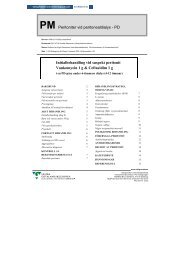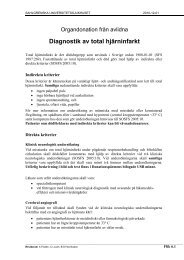M Rizell, R Hultborn, P Bernhardt, J Svensson, M Sternby Eilard, O ...
M Rizell, R Hultborn, P Bernhardt, J Svensson, M Sternby Eilard, O ...
M Rizell, R Hultborn, P Bernhardt, J Svensson, M Sternby Eilard, O ...
You also want an ePaper? Increase the reach of your titles
YUMPU automatically turns print PDFs into web optimized ePapers that Google loves.
assumed that this treatment would be done up front at diagnoses of metastases, like in the<br />
randomized studies, the cost per gained year would be 572 000 SEK (57 200 €), (nb. cost<br />
per gained year is not the same as QALY).<br />
Are the survival data in the published studies representative of Swedish conditions? A<br />
recent Swedish population based study reported a median survival of 18 months in patients<br />
with metastatic cancer confined to the liver only and treated by chemotherapy (Sjövall et<br />
al., 2004), i.e. similar to the data in the randomized trials in which treatment was started at<br />
the time of diagnosis of hepatic metastates. The case series had a shorter survival of 12.7<br />
months (simulated control 9.6 months), which is reasonable or rather high with regard to<br />
the late stage of these patients.<br />
How does the cost of gained year of radioembolization with 90 Yttrium compare with<br />
currently used chemotherapy?<br />
The incremental cost of oxaliplatin added to 5-FU and folinic acid in the first line<br />
treatment of metastatic colon cancer is approximately 500 000 SEK (50 000 €) per gained<br />
year: More recently the incremental cost of the anti-angiogenic monoclonal antibody<br />
bevacizumab or the epidermal growth factor receptor-antibody cetuximab added to 5-FU<br />
and oxaliplatin or irinotecan is in the range of 1-2 million SEK (100 000 – 200 000 €).<br />
Unanswered Questions<br />
10a. Important gaps in scientific knowledge?<br />
In the included studies there have been no reports of dose-response relationship, possibly<br />
due to the imperfect methods used for absorbed dose estimates. Most methods used to<br />
calculate the amounts of 90 Yttrium-microspheres administrated to patients are probably<br />
suboptimal. The radioactivity administrated to the patients are based on three different<br />
approaches: the empirical method, the body surface area (BSA) method and the partition<br />
model. Most of the studies presented in the literature have used either the empirical or the<br />
BSA method. However, both methods calculate the absorbed dose to the liver tissue<br />
indirectly, and, consequently, the obtained absorbed doses to the liver tissue will vary<br />
widely between patients. A retrospective analysis of the BSA method applied to the first<br />
16 patients treated at the Sahlgrenska University Hospital showed that the mean absorbed<br />
doses to the liver tissue ranged from 15 to 60 Gy.<br />
The partition model is a direct dosimetric model. The calculation of the absorbed dose to<br />
the liver is based on CT measurement of the liver and tumour volumes. This method<br />
clearly increases the precision in the estimation of the absorbed dose to the liver. A higher<br />
precision may yield an increased knowledge in the dose-response relationship, and<br />
minimise the risk of administrating too low activity amount- thereby lowering the<br />
therapeutic effect, as well as it might enlarge patient safety. Furthermore, a study based on<br />
accurate dosimetry may improve the selection of good tumour responders. Patients with<br />
good tumour response to treatment may also be suitable candidates for additional<br />
treatments, which further could increase their lifespan.<br />
16(19)


